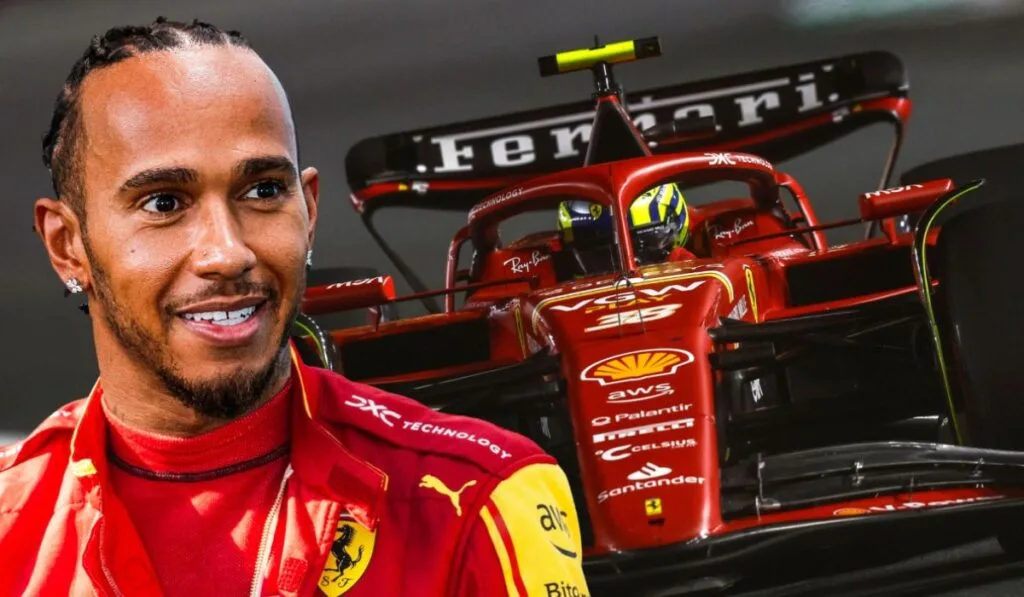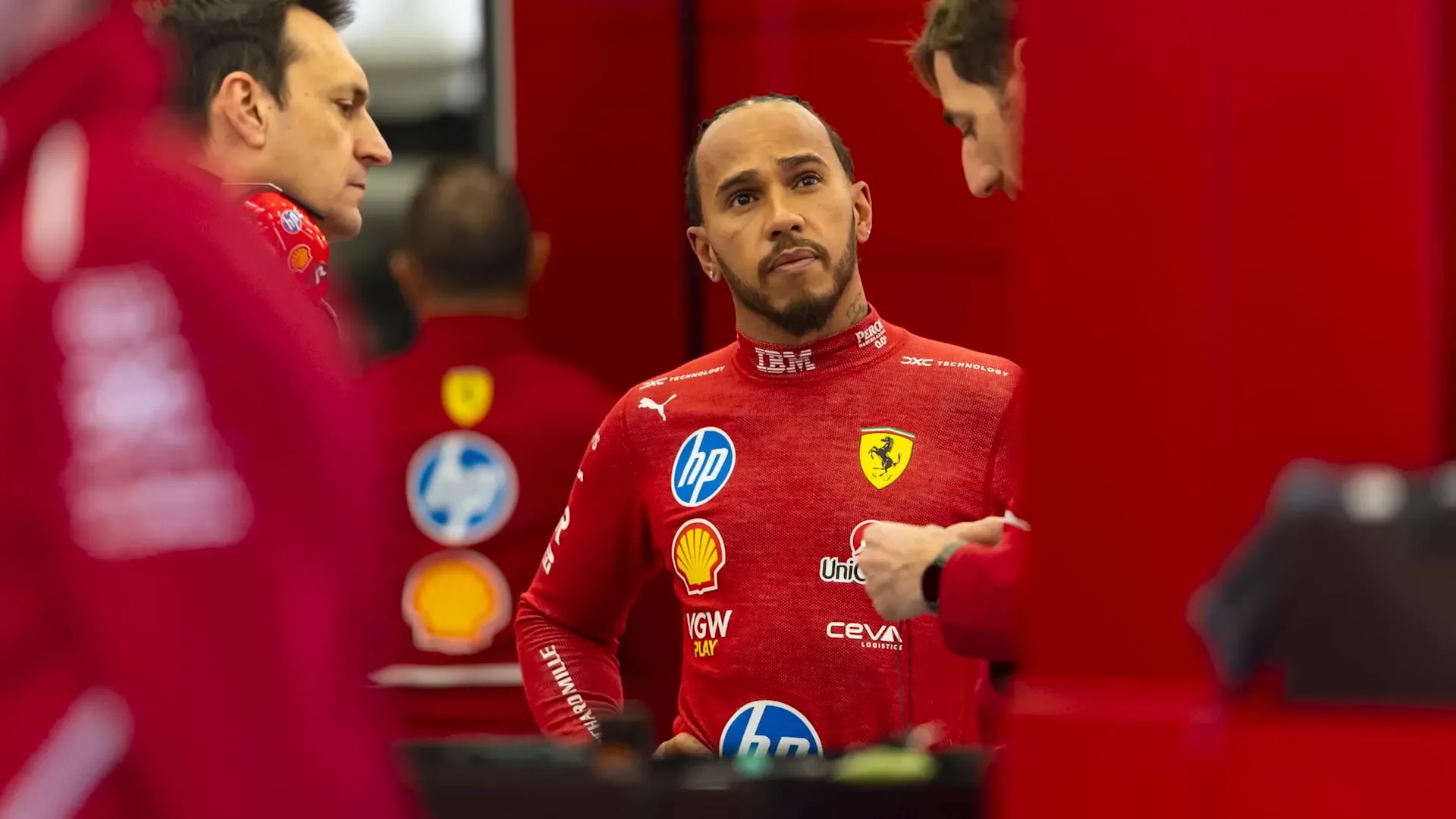In the high-octane world of Formula 1, whispers travel faster than the fastest car on the grid.
But sometimes, those whispers evolve into a thunderous roar, especially when a revelation of seismic proportions shakes the very foundations of the sport.
Such a moment arrived recently when Lewis Hamilton, the seven-time world champion, was confirmed to be behind the wheel of Ferrari’s enigmatic SF25 mule car at Mugello.
This wasn’t merely a test drive; it was an act laden with intrigue, a strategic maneuver that could either herald a new era of Ferrari dominance or expose the Scuderia’s deep-seated vulnerabilities.

The genesis of this extraordinary event lies in Hamilton’s own words, uttered with a quiet frustration that belied their profound significance: “We’ve been progressing, yet we’ve not had results.” These six words, spoken after a challenging race, illuminate a secret Ferrari strategy that has now been exposed for the world to scrutinize. The twist? Lewis Hamilton, fresh into Maranello, is being drafted into a confidential test that isn’t just a seat swap; it’s a profound reveal, an unprecedented opportunity for him to experience Ferrari’s future firsthand, and for Ferrari to harness his unparalleled experience.
The confidential test plan unfolded on September 25th and 26th at Mugello, where Ferrari and Pirelli ran a private program focused on next year’s tires. Pirelli’s Mario Isola confirmed the schedule, stating, “On September 25th and 26th, we will be on track with Ferrari and H, working on a program aimed at defining the hardest compounds for next year.” The “H” in his statement, it turns out, was not a mere placeholder but a veiled reference to Hamilton himself. He, along with Charles Leclerc, shared driving duties in the SF25, a stark and sensational image that would have been unimaginable just a few seasons ago. Adding to the intrigue, reserve drivers Guanyu Zhou and Arthur Leclerc took the SF23 for TPC sessions (Test and Practice Car runs) on Thursday, September 25th, keeping them sharp and potentially contributing to the broader development picture, as Ferrari has done before with drivers like Giovinazzi and Fuoco for evolving suspension parts.
But why is Hamilton’s involvement such a monumental deal? Because the SF25 is no ordinary Ferrari. It’s a specialized “mule car,” a development vehicle carrying low-downforce wings and a special system simulating a front flap opening—all designed to mimic the radical aerodynamic rules slated for 2026. In essence, Ferrari is using this car to probe weak points, simulate future performance, and gather invaluable data under conditions their rivals can’t yet see or replicate. The last time this particular mule car raced was in Hungary, with Leclerc at the helm. Now, Hamilton enters the cockpit, gaining firsthand experience of Ferrari’s secret development trajectory. It’s not just testing; it’s an act of automotive espionage, conducted in the tight confines of a race suit.

Before delving further into the implications, it’s crucial to recall Hamilton’s candid admissions about his adaptation to recent cars. He confessed after Azerbaijan, “I’m still learning the car, especially braking. I think there’s still some improvements to make in terms of how aggressive I can be. The car has been quite snappy, so still not 100% confident under braking when I’m attacking on the brakes.” He then added the aforementioned telling phrase: “It’s kind of crazy because we’ve been progressing yet we’ve not had results really in the last few races.” This admission is deeply revealing. On one side, it shows a rare vulnerability from a driver of his caliber; on the other, it signals a kind of insider access. Hamilton knows something fundamental is shifting beneath the skin of the cars he drives, and now, he’s privy to Ferrari’s most profound internal shifts.
Ferrari, it must be said, is currently under immense pressure. The SF25 carries flaws, despite the team’s bold promise that 99% of the car would be new compared to its 2024 predecessor. They reintroduced a pull-rod front suspension to replace the push-rod system, a technical gamble that has, in turn, exposed mechanical instability in the rear. The technical gut of the machine isn’t fully sorted. Their attempt at an evolutionary rear suspension, aimed at reducing tire wear, improving stability under braking, and enhancing traction, has so far yielded minimal performance gains. Analysts have measured the improvement in lap times before and after this upgrade at a meager 0.040 seconds—a paltry 40 thousandths, almost nothing in the brutal calculus of F1. Meanwhile, Ferrari’s points average has disturbingly collapsed from 17 to 11.8, painting a bleak picture of stagnation in multiple areas and a loss of technical audacity.
In this context, Hamilton’s role transcends mere symbolism. Ferrari is effectively thrusting him into the deepest echelons of their development process. They are letting him feel the limits, test where doubt is deepest, push components whose real performance is yet unknown, and, crucially, catch what their own engineers might miss. It’s a high-stakes gamble, especially given the tense internal atmosphere within Ferrari. Outside observers already perceive a timid behavior creeping into their race weekends, a sign that words from the principal alone won’t suffice. The machine, the numbers, and ultimately, the track must respond.

Hamilton’s straightforward assessment—”In the last race we’ve been progressing, yet we’ve not had results”—is simple yet heavily loaded. He’s subtly communicating that something fundamental is being built underneath, not yet visible in race results. He’s also signaling that he is now an integral part of this unseen construction. This Mugello test, with him in the SF25, is not just a driver switch; it’s an unveiling. The secret Ferrari program meets the man who can feel its deepest truths.
What’s truly wild is Ferrari isn’t even attempting to hide this anymore. They’re not whispering it through back channels or filtering it through vague statements. They are openly putting Hamilton, a man who spent 12 years building Mercedes into a juggernaut, into their most future-forward prototype. The symbolism is electric, but the risk, even greater. Consider what this means for Mercedes. Hamilton is now driving a test car that simulates the 2026 regulation era—an era Mercedes themselves are scrambling to prepare for. And Hamilton, with nearly two decades of data, instinct, and unparalleled experience locked in his head, is now absorbing Ferrari’s trajectory from the inside. Every vibration, every braking irregularity, every twitch of understeer—Hamilton feels it all, logs it mentally. What he communicates to Ferrari’s engineers could very well define how they attack the next generation of Formula 1.
The kicker, however, is that even with this so-called progress, Ferrari’s numbers are sliding in actual races. They are going backward. That experimental rear suspension they had such high hopes for has delivered no substantial leap. The dropping points average unequivocally proves it; the car’s performance evolution looks more like a stumble than a stride. This stark reality underscores why the Mugello test is a do-or-die moment. Why else would Ferrari wheel out Hamilton this soon? They need answers, and they need them fast.
The situation becomes even spicier when zooming out. The SF25 doesn’t dominate on any particular track; it’s now arguably the fourth-best car on the grid. In Baku, Ferrari even lost second place in the constructors’ championship to Mercedes—Hamilton’s old team. The irony is palpable. The team had what may have been one of its last real chances to secure a win this season, but with Leclerc crashing in qualifying and Hamilton only climbing from P12 to P8, the result was a dull thud. Hamilton’s post-race comments to Sky F1 were telling: “I mean I’m happy I moved forwards from 12th, but couldn’t really care less for that position.” That’s not a man celebrating minor gains; that’s a man relentlessly hunting for transformation. The real story isn’t just the race result; it’s what Hamilton said afterward: “Our ultimate pace in the race was just not on par with the guys up ahead of us.” And then, perhaps the most revealing line of all: “I think ultimately we went in the wrong direction with the car.”
Now, put that in context with Ferrari’s clandestine efforts. They’re pushing all in on secret component trials, controlled mule car data, and intense testing at Mugello. They are engineering in the shadows because they understand that current public results cannot speak for them yet. That’s why this Mugello test is a turning point. Ferrari desperately needs Hamilton to feel something their data isn’t showing. Numbers alone are no longer sufficient. They need raw, unfiltered driver instinct, and not just from Leclerc, who has been there long enough to potentially normalize existing flaws. They need the fresh, critical perspective of a veteran like Hamilton, still on the outside looking in, despite being inside the car.
It’s poetic, in a way. The same man who for years systematically dismantled Ferrari’s hopes is now being asked to resurrect them. But what if it doesn’t work? What if Hamilton climbs out of that SF25 mule car, looks his engineers dead in the eye, and delivers the devastating verdict: “It’s not good enough.” What if these secret tests only confirm the worst—that Ferrari’s 2026 path is already fundamentally misaligned with where Formula 1 is truly heading? This is the Ferrari dilemma in its starkest form: they are desperate to evolve but simultaneously terrified of the revolutionary changes required. And Hamilton, knowingly or not, has become the unwitting catalyst.
So, the fundamental question lingers: Is Lewis Hamilton the ultimate key to unlocking Ferrari’s future dominance, a strategic masterstroke that will propel them to glory? Or is he merely a mirror, reflecting back to them how painfully far they still have to go? This isn’t just another test; it’s a reckoning. The Mugello sessions are a pressure cooker for Ferrari’s technical soul, and as fans, we are left on the absolute edge of our seats, wondering: what will Hamilton discover behind Ferrari’s closed doors? Will this secret test truly change everything, or will it tragically reveal that, despite all the fanfare and all the hope, nothing has truly changed at all? The road to 2026 just took a wild and unpredictable turn, and its ultimate destination remains a captivating mystery.





